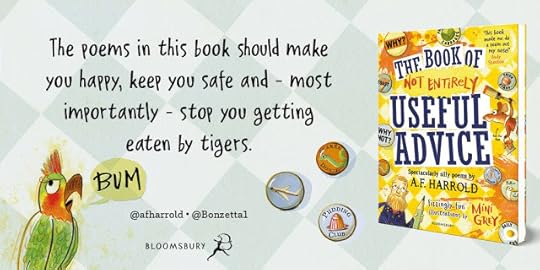Moira Butterfield's Blog, page 11
July 4, 2022
The Story We Can’t Tell Our Children - with Mini Grey

In which Mini listens to too much radio and thinks about apocalypses
Talking on the radio recently, Neil Gaiman recounts how his daughter Holly, at 4 years old, delighted in scary stories. She would come home, climb on his lap and dictate hair-raisingly creepy tales to him - which ended up being the inspiration behind his book Coraline. “That was what she loved,” said Neil of the terrifying stories. Neil remembers going to a bookshop in Uckfield and saying “What have you got in the way of good horror for four year olds?” and discovering that this thing didn’t exist yet. He says “I think it’s a wonderful think to be in control of our fear. We like scary stories for the same reason that we like going on rides at funfairs…the fictional fear is the joy of being in control… You can always put the book down.”

It’s not just children who delight in scary stories – grown ups do too.
Maybe that’s a reason people have always imagined they’re living in the End Times, that they are the last people at the end of the world. The story of Apocalypse is an old one, one of the oldest stories humans tell. An Assyrian clay tablet dating to around 2800 B.C. bears the inscription: “Our Earth is degenerate in these later days; there are signs that the world is speedily coming to an end; bribery and corruption are common; children no longer obey their parents; every man wants to write a book and the end of the world is evidently approaching.” In olden times it was usually a cataclysmic intervention of God that was going to happen, but by the time I was a child it was going to be nuclear war that ended everything; see Raymond Briggs’s When the Wind Blows.
 And now the End Times is our Ongoing Planetary Climate Emergency.
And now the End Times is our Ongoing Planetary Climate Emergency. In his Radio 4 series ‘Tipping Points’ , Justin Rowlatt addresses the people of 2122, 100 years on: What will their lives be like? What will they think of us? What would we like to say to them? What stories will they tell about us and what we were up to 100 years ago? “Tomorrow’s generations will have a lot to say about what we do now and the choices we make.”
And in a story you can imagine future Earthlings; it could be very useful to us now to imagine what future Earthlings will say about us..

The Arctic and the Amazon rainforest – are critical planetary regulators that drive the weather and climate of our planet. And they’re both teetering on tipping points, both about to slide (or maybe already sliding) into a new state – which will be, possibly: a warming ice-free Arctic in summer; and, possibly, eventually, savannah where most rainforest used to be. And this will mean: a stalled meandering Polar Jet Stream (the air current that usually circles the Arctic) bringing extreme blocked weather events – heat or flooding; and loss of the most biodiverse region on earth and all that breathing out of clouds and rivers in the sky that the rainforest does. A warm Arctic means loss of the temperature differences between poles and equator on land and sea which will disrupt ocean circulation. And all these changes will be too fast for wild animals in earth and sea to adapt. Our present CO2 levels are around 420 ppm,. To find a planet like this you have to go back in your time machine to 3 million years ago: then, Earth’s climate was 3 degrees warmer, and much warmer at the poles with no Greenland ice sheet and much higher sea levels:. this is the equilibrium the Earth will aim for with our present CO2 levels.
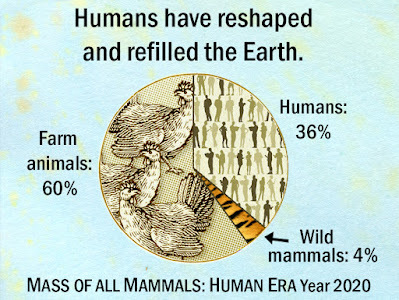
If a palaeontologist in the far future – let’s say in 65 million years time, the distance we are from the dinosaurs – was to look at what happened between 10,000 years ago and now in the fossil record, they’d probably conclude, if they didn’t know better, that there’d been a mass extinction event. One moment, (10, 000 years ago) 96% of mammals on earth are all sorts of diverse wild fauna, and then, suddenly, they nearly disappear (becoming 4% of all mammals today) and the rest - 96% of mammals - are suddenly humans and their domesticated animals. Palaeontologists of the future would think a mass extinction had already taken place – something had happened to make all that wildlife disappear, and a ‘disaster taxa’ of animals that can live anywhere and aren’t fussy (humans and their animals) had spread everywhere, a bit like how lystrosauruses colonized the planet after the super-disastrous end-Permian mass extinction .
And future Earthlings are already with us: what do our children think about what Earth’s grown-ups are doing now to tackle climate change, and the double threats of global warming and biodiversity loss?

Although he’s been on Friday for Future marches, I didn’t think my 15 year old son Herbie would want to talk about the Climate Emergency – it could be a bleak outlook ahead for young people. But when I ask him, his answer is surprising.
Herbie says: “A mammal species usually lasts a few million years. So we could say the human species could be destined to last a million years at the bare minimum. Which means, if we don’t make ourselves extinct – (which it is very unlikely for us to do, even if we make the Earth very difficult to live on) – we’re not at the end, we’re at the very start of the whole human race. We’ve got 800 000 years at least ahead of us.”
There could be a shift in perspective of where we are in the story – maybe we’re at the beginning rather than the end. Which makes what we do now even more important.

One thing I learned from researching and making my latest book, The Greatest Show on Earth, is this:
It’s amazing and terrifying to know that, in Earth’s history, complex animal life has occasionally been REALLY close to being snuffed out (the worst ever was 252 million years ago). The Earth has sometimes been a TERRIBLE place to live in the past (possibly even trying to get rid of life, you could suspect…): there have been huge volcanic lava outpourings, there have been tremendous freezes, there have been times when the ocean became anoxic and hostile to life.About 20 thousand years ago a cold world that swung erratically in and out of ice-ages started to thaw and turn into the gentle friendly stable climate of the Holocene where us modern humans have made our homes, and that benevolent climate – not too warm or too cold – is what we – and everyone else on the planet – is used to. And it’s been a lucky time: no big asteroid strikes, no massive lava outpourings.

But now we realise that just one animal, us, is controlling the whole planet…but it’s not in our control. And if certain tipping points get triggered, it will roll into a new climate mode, and there will be nothing we can do to push it back to something like the dear old friendly Holocene.
We are living in a critical moment for our planet.
 And also in making the Greatest Show I discovered – we are only half way through the life of our Earth and Sun – there’s a whopping 500 million years left for animal life of all sorts – for “endless forms most beautiful and most wonderful” to evolve . The Tape Measure of Time which is unrolled by Anton, Anatole and Annette the ant Time Team, is at a scale of one centimetre to a million years. When you think that all of Homo Sapiens’s business is contained in the last three millimetres of the last one centimetre on the Tape Measure of Time, and we feel that even those few hundred thousand years is a long long time, imagine the vast time distances that stretch before us. All the Holocene is contained in the last tenth of a millimetre of the Tape Measure of Time; just rolling out another centimetre takes us a million years into the future – and there’s a possible 5 or 6 metres of time still to come.
And also in making the Greatest Show I discovered – we are only half way through the life of our Earth and Sun – there’s a whopping 500 million years left for animal life of all sorts – for “endless forms most beautiful and most wonderful” to evolve . The Tape Measure of Time which is unrolled by Anton, Anatole and Annette the ant Time Team, is at a scale of one centimetre to a million years. When you think that all of Homo Sapiens’s business is contained in the last three millimetres of the last one centimetre on the Tape Measure of Time, and we feel that even those few hundred thousand years is a long long time, imagine the vast time distances that stretch before us. All the Holocene is contained in the last tenth of a millimetre of the Tape Measure of Time; just rolling out another centimetre takes us a million years into the future – and there’s a possible 5 or 6 metres of time still to come. Looking into the future is so difficult: even looking forward 50 years is hard.


Can we go through the Crystal Ball: what COULD the future be? Can we get in an imaginary time machine and travel to a thousand years in the future?.
The secret special fantastic superpower of humans is our crazy overactive imaginations. And those imaginations feed on the power of story: story lets us share collective imaginary ideas like nations, money, gods, the past and the future.
With stories and empathy we can imagine the far future, and what that
might be like.
Can we imagine Earth is 1000 years time? 10,000 years time? 100, 000 years time? What could a planet where humans and the rest of nature live in balance be like? How much space would each need?
Then we can start working out what we have to do to get there.
So here it is:
The Story We Can’t Tell Our Children.
Here’s how the story starts:
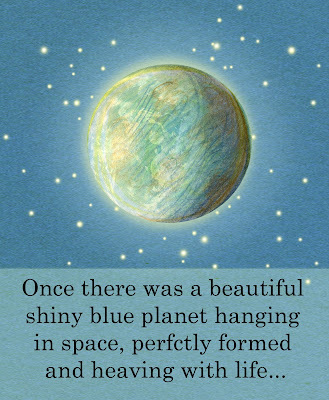
But this story has a sad ending: the wild animals disappear, and Earth ends up a bit inhospitable. Actually I can't tell you this story. It's just too sad.
So I'll tell you a story that was once in my book, Space Dog, about a furry planet.

Imagining our possible futures is useful. It can help us work out what’s important. Imagining what future people will say about us who are on Earth now is useful. Having an imagined conversation across time with future beings could be useful, to galvanise ourselves into making changes now.
So back to the APOCALYPSE: The original word in Greek — apokalypsis — means an unveiling, a revelation. An apocalypse helps us see something that was hidden before.
Maybe our story can have a different ending.
So here it is: The Story We Might Wish our Children will tell:
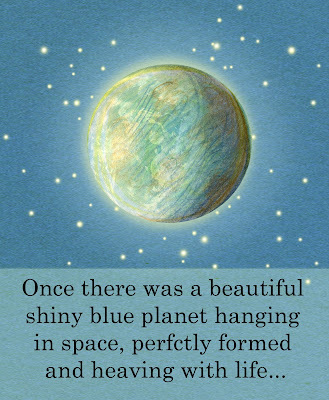
And this story has many possible happy endings. Here's just one.
And then the people of Earth decided they wanted to make sacrifices right now so they could give their planet a good future: they asked their governments to put a price on carbon dioxide and methane so it was expensive to pollute Earth’s atmosphere with them. They stopped eating meat – except for special treats – so they could give back half of Earth’s land surface to nature, and everything they planned and made from then on, was planned to give more habitat to wildlife. And people and planet eventually at long last were in balance.
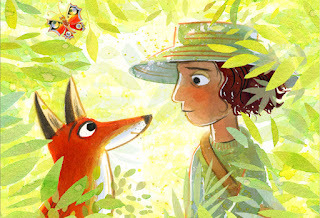
And how on Earthdo we get to the happy ending?
Well, all you story-makers, that’s another story….
Mini’s latest book is The Greatest Show on Earth, published by Puffin.

June 26, 2022
Different perspectives by Jane Clarke
I’ve always loved picture books that show the same event or story from different perspectives, and/or empower the child ‘reader’ to feel as if they know more than the characters on the book.
Here are a few of my favourites. They date back a while, but then again, so do I…
Rosie’s Walk written and illustrated by Pat Hutchins
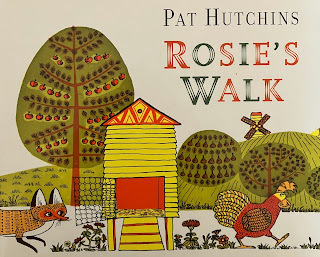
Rosie the hen is completely oblivious to the dangerous fox stalking her, but the reader is in the know.
The Bottomley books by Peter Harris, illustrated by Doffy Weir

In Bottomley, Cattery, Bottomley the cat's account of what went on during his stay at the cattery doesn’t quite match that of the owners of the cattery and fellow guests.
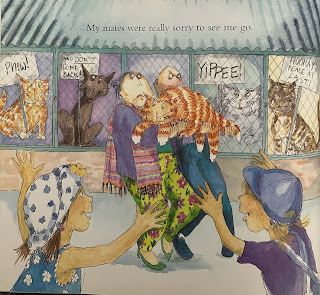
The Doctor Xargle books by Jeanne Willis, illustrated by Tony Ross - in which Dr Xargle leads a class of small aliens to discover much about the habits of the strange creatures who live on Earth. Only Dr Xargle doesn’t get it quite right…
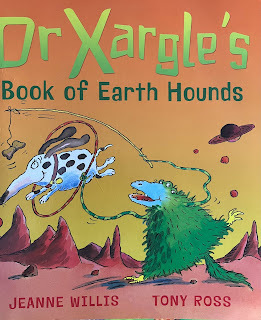
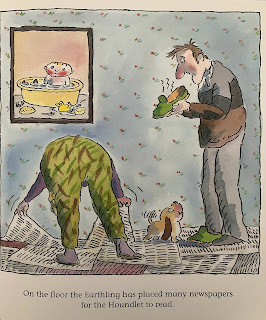
Different perspectives have crept into a quite a few of my own picture books. So I’m delighted that my newest about-to-be-published picture book also plays with perspective - on a subject dear to my heart.
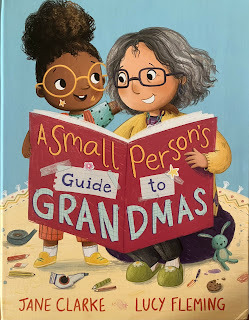
In A Small Person’s Guide to Grandmas, illustrated by Lucy Fleming, the small person’s views are not telling the whole story - something I hope will bring a smile to the face of a happily exhausted Grandma reading the book to their very own small person.
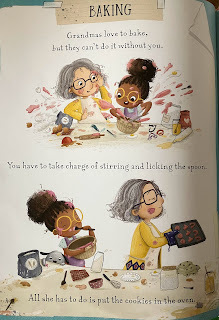
This week, Jane's a very happily exhausted grandma, as she has her rapidly-getting-larger small people, UK and USA varieties, all together for the first time since the pandemic.
June 19, 2022
Pride Month Picture Books, a celebration! - Garry Parsons

Pride Month is in full swing and this year the UK celebrates 50 years of the Pride movement. For the month of June, members of the LGBTQ+ community and their allies celebrate their identities, accomplishments, and reflect on the struggle for equality.
Pride Month marks the police raid that prompted the Stonewall riots which in turn led to the establishment of LGBTQ+ rights. The raid took place during the early morning of June 28, 1969, at the Stonewall Inn in Greenwich Village, Manhattan, a popular gathering place for young gay men, lesbians, bisexuals, and transgender people. The LGBTQ+ community held a series of demonstrations to protest against the raid and called for the establishment of safe spaces for gay people, where they could congregate without fear of being arrested or becoming victims of violence. These riots served as a catalyst for the rights of LGBTQ+ people. Since then, the LGBTQ+ community annually commemorates the years of struggle for civil rights and the ongoing pursuit of equality in the form of a pride celebration, now widely observed with parties, parades, concerts, and other events that celebrate a diverse identity.
In the UK, the first official UK Pride Rally was held in London on July 1, 1972 (chosen as the nearest Saturday to the anniversary of the Stonewall riots of 1969) – so 2022 marks the 50th year of the Pride movement in Britain.
So what does this have to do with picture books? Well, we are all different to a greater or lesser degree and every day we meet people different from ourselves. It is vitally important that children get to read about all different types of people and families to promote an attitude of empathy and acceptance. Everyone should be able to see themselves represented in the books they read to support a positive environment for each of us so we can be free to be who we are.
I've picked out some examples of brilliant picture books supporting diversity and asked some of the creators involved for their views on what Pride month means to them personally and why picture books are so important.
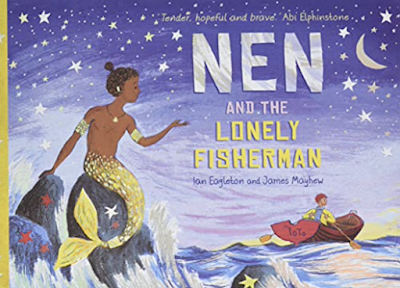 Nen And The Lonely Fisherman - Ian Eagleton & James Mayhew
Nen And The Lonely Fisherman - Ian Eagleton & James MayhewJames Mayhew is the illustrator of Nen and the Lonely Fisherman.
"For me, Pride month is both an opportunity to celebrate and feel part of an amazing, welcoming community and also a time to reflect on those who fought so hard for LGBTQ rights and how we must never take those rights for granted. The future relies on educating people and that's why I feel strongly that we need picture books to show children positive examples of different kinds of relationships. For too long the heteronormative 'happy ending' has reinforced the problem. Books like Nen and the Lonely Fisherman gently teach acceptance and empathy." - James Mayhew.
 Nen And The Lonely Fisherman - Ian Eagleton & James Mayhew
Nen And The Lonely Fisherman - Ian Eagleton & James Mayhew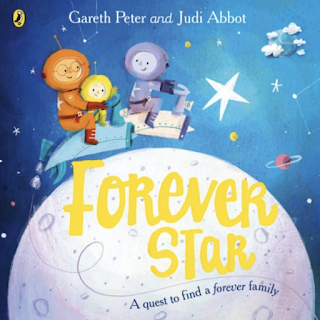 Forever Star - Gareth Peter & Judi Abbot
Forever Star - Gareth Peter & Judi AbbotGareth Peter is the author of Forever Star illustrated by Judi Abbot, a rhyming story about a same sex couple adopting a child.
"To me, Pride means family. We have a two daddy family and we have adopted two amazing boys. This was all possible because of Pride and all that the amazing LGBTQ plus community have done. So I will always be thankful and appreciative of Pride for allowing my dream to come true and become a dad. Pride should always be a colourful, accepting, tolerant and happy celebration and that's just like our family. Happy Pride everyone!" - Gareth Peter.

Harry Woodgate is the author and illustrator of Grandad's Camper. In this moving story, Grandad tells his granddaughter about the adventures he used to have with Gramps.
"Pride is a wonderful opportunity to celebrate our LGBTQ+ friends, family and community, but more than anything I feel that it's a time to reflect on and campaign for the progress that still needs to be made, especially in the face of increasingly damaging legislation.We know children's books are powerful tools for building empathy, kindness, confidence and emotional literacy, which is why it's so important that every child is able to access literature which is why it's so important that every child is able to access literature which reflects a diverse and inclusive range of identities, experiences and family setups." - Harry Woodgate.
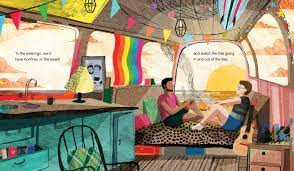
 Grandad's Camper - Harry Woodgate
Grandad's Camper - Harry Woodgate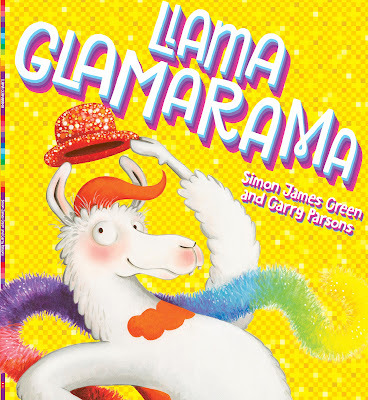 Llama Glamarama - Simon James Green & Garry Parsons
Llama Glamarama - Simon James Green & Garry ParsonsSimon James Green is the author of Llama Glamarama, a story celebrating differences and of being true to yourself.
"One element of Pride is about being true to yourself, living your life fearlessly and boldly, and celebrating everything that makes you unique. I think that's something everyone should embrace, whatever their age and that's why it's so important to see that message in picture books" - Simon James Green.
For me, Pride month is an uplifting recognition of the strength of my identity and a validation that whatever family set up you have, a family is a family. Here are a few more picture books worthy of your attention this June and in the months and years beyond.
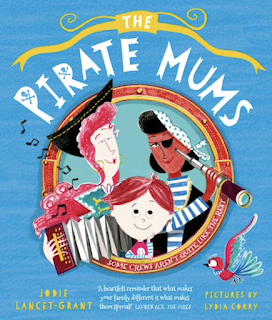 The Pirate Mums - Jodie Lancet-Grant & Lydia Corey
The Pirate Mums - Jodie Lancet-Grant & Lydia Corey The Pirate Mums - Jodie Lancet-Grant & Lydia Corey
The Pirate Mums - Jodie Lancet-Grant & Lydia Corey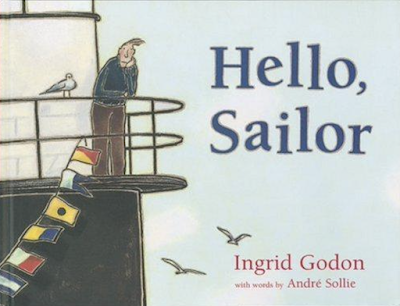 Hello Sailor - Andre Sollie & Ingrid Godon
Hello Sailor - Andre Sollie & Ingrid Godon Hello Sailor - Andre Sollie & Ingrid Godon
Hello Sailor - Andre Sollie & Ingrid Godon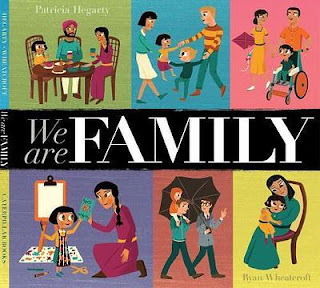 We Are Family - Patricia Hegarty & Ryan Wheatcroft
We Are Family - Patricia Hegarty & Ryan Wheatcroft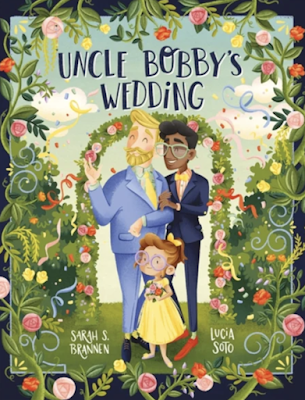 Uncle Bobby's Wedding - Sarah S Brannen & Lucia Soto
Uncle Bobby's Wedding - Sarah S Brannen & Lucia SotoHappy Pride Everyone!

***
Garry Parsons is an illustrator of children's books and the illustrator of My Daddies! also written by Gareth Peter. A picture book celebrating same-sex parents, shared story time and introducing children to the different kinds of family in the world today.
My thanks to James Mayhew, Gareth Peter, Harry Woodgate and Simon James Green for their heartfelt contributions. Garry's work can be seen hereFollow Garry on twitter and instagram @icandrawdinos
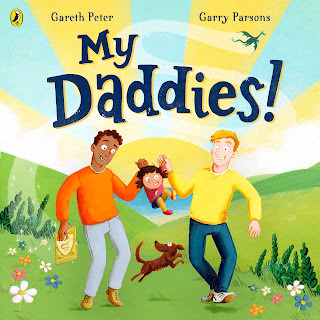
June 12, 2022
Checking roughs – a vital picture book author skill Moira Butterfield
I was inspired to write this blog after reading an interview with actor and writer Brett Goldstein, co-creator of the marvellous Ted Lasso TV series. He emphasised how important attention to detail was in his work. He also told the story of visiting the set of Sesame Street and being really impressed by the attention to detail that was evident as part of the team’s passion to make the work the best it could be. He even saw Elmo giving script notes!
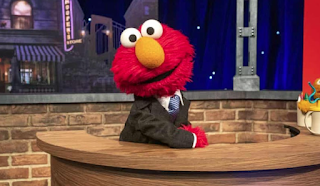 Elmo likes things to be just right, and so do I.
Elmo likes things to be just right, and so do I.
It struck a chord with me because picture book authoring requires great attention to detail – especially non-fiction picture book work. There are checking stages the author will be asked to do and they require concentration, care and even a measure of diplomacy. It’s a vital part of being an author of illustrated books – a vital part of making good work.
I‘m asked to check illustrator pencil roughs and then the colour work. I’m checking to ensure the illustrator has correctly interpreted the factual details of my text. The artist has invariably done a wonderful job and I take care to tell the editor so, whilst pointing out any things that need correcting.
I’m not making purely subjective comments on the art but I point out factual errors - perhaps a beak is the wrong shape on a bird I’ve named or a creature is missing its tail, for example. I’m also checking for mismatches between the pictures and what is said in the text. So if I’ve mentioned, say, a particular creature and it hasn’t appeared as it should on the page.
Occasionally, if the art is now in colour and it doesn’t affect the book, I might make a small text change to accommodate a new picture and make the work correct. Here are some examples of things I spotted in the last few days, just to show you the kind of detail I might point out.
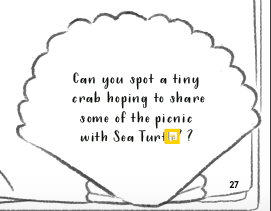 There was no crab to spot.
There was no crab to spot. 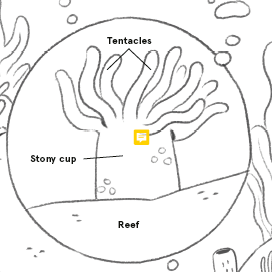 The coral cup needs a line to separate it from the tentacles.
The coral cup needs a line to separate it from the tentacles. 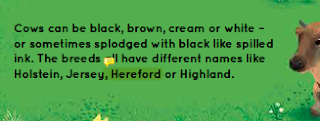 I changed the text here because Herefords weren't illustrated.
I changed the text here because Herefords weren't illustrated.  The grass wasn't drooping like a mini arch.
The grass wasn't drooping like a mini arch.
The writer should not point out errors with a heavy hand. You don’t want your reaction to sound like this: “Ha ha! Good for me! I found something!”. It ought to sound like this: “The illustrator has done a great job. I really appreciate the efforts made. Here are my comments. I hope they help. Do come back to me to discuss them if you would like.”
 Be this!
Be this!
It takes significant work time to do a thorough check on an illustrated non-fiction book. In fact it’s a good idea to check everything twice – and then even look again the next day if you have the schedule time and the book has lots of detail.
Recently I had a spread up onscreen when a friend arrived and I explained what I was doing. “Oh kids won’t know it’s wrong,” she remarked, but they very well might and I certainly would. It does matter because attention to detail is a part of a writer’s creative passion, as Brett Goldstein pointed out. It’s necessary to make the book the best it can be, and that’s what I want for every book I write.
Moira Butterfield is the author of many non-fiction picture books, most recently Maya's Walk, illustrated by Kim Geyer (Oxford University Press) and Grandma's Story, illustrated by Salvatore Rubbino (Walker Books).
www.moirabutterfield.co.uktwitter @moiraworld instagram @moirabutterfieldauthor
June 5, 2022
The (Lost) Spark of Back-and-Forth Collaboration? • by Natascha Biebow

Once acquired by a publisher, picture books are made by collaboration – a whole team behind the scenes, including the illustrator, the author, the editor, designer and production team works closely together to share their expertise and to build upon the creator's initial ideas. Once made, picture books look seamless: all those collaborative discussions are evident in the polished book. Now, there will be people championing it in the publisher’s marketing, sales, rights and publicity departments.
 Many hands collaborate to make a picture book that shines
Many hands collaborate to make a picture book that shinesSometimes, a collaboration is established in a particularly inspired author illustrator pairing that will go on to endure and delight countless young readers.
But what of the collaboration between the creative and the first point of contact – usually the editor at the publishing house? The kind that takes time and a special kind of eye to see the seed of something special and commercial and then time and effort to let it ‘cook’ till it shines. Is it a lost art?
In the US, recently several junior editors quit their roles citing being overworked and lack of proper recognition for their creative contributions to the business of making bestselling books. Increasingly we hear reports of submissions going unacknowledged in overflowing ‘slushpiles’ and overtasked editors. It stands to reason, then, that editors would want book proposals to arrive on their desks as polished projects that they can immediately envision in terms of potential. These they can effectively ‘run’ with as they pitch them in-house for acquisitions.
But what if . . .?
Editors once again had a bit of time and spaceto connect and collaborate back-and-forth, to nurture artists and authors at all levels of their career?
What if . . .?
Writers, editors, illustrators and art directors could meet in a kind of ‘writer’s room’ scenario like teams creating movie and TV series do?
What if . . . ?
Authors (and illustrators) with talent received encouragement and direction to work collaboratively with editors to help them take their ideas to the next level rather than just receiving no response or even an outright rejection to a project that has a seed of promise? Could it elicit a spark that later led to great works?

What if . . . editors had more time and space . . .
to reach out, to nurture a spark,
to collaborate in a conversation . . .?
Writing letters may be a lost art, and emails are often at best short and business-oriented – everyone is so busy and short of time - but knowing that an editor is in your corner can mean the difference between being able to create the next big masterpiece or not.
Take for example the pivotal role legendary editor Ursula Nordstrom (1910–1988) played in bolstering Maurice Sendak at a key time in his early career, eventually leading him to believe in himself enough to go on to create the enduring classic Where the Wild Things Are.
When Sendak expressed his self-doubt in being able to stack up to the genius of Tolstoy and illustrate his work, Ursula wrote:
“Sure, Tolstoy and Melville have a lot of furniture in their books and they also know a lot of facts (“where the mouth of a river is”) but that isn’t the only sort of genius, you know that. You are more of a poet in your writing, at least right now. Yes, Tolstoy is wonderful (his publisher asked me for a quote) but you can express as much emotion and “cohesion and purpose” in some of your drawings as there is in War and Peace. I mean that. You write and draw from the inside out — which is why I said poet.
…
You are growing and getting better all the time. I hope it was good for you to write me the thoughts that came to you. It was very good for me to read what you wrote, and to think about your letter.
….
You may not be Tolstoy, but Tolstoy wasn’t Sendak, either. You have a vast and beautiful genius.” *

According to HarperCollins' website, 'Nordstrom had a simple philosophy regarding new authors. As one colleague said, “Anyone who called, anyone who got off the elevator, anyone who wrote in, could be seen and heard.” She always answered her own phone, and on hearing another ringing, would cry out, “Answer that! That might be the next Mark Twain.”'
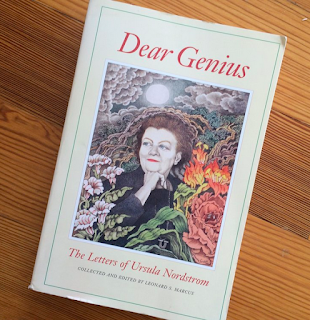 Dear Genius The Letters of Ursula Nordstrom
Dear Genius The Letters of Ursula NordstromCollected and Edited by Leonard S. Marcus
I wonder if some of our great children’s picture books would have even come to fruition and evolved in quite the same way without the space and support to experiment and collaborate with editors and art directors?
Having the
friendship and support of a
teacher and mentor and listener to
bolster creative confidence
sounds like a real gem in this day and age. That TRUST and FAITH! Hopefully it isn’t too elusive and the ways can be found to bring back that back-and-forth collaborative spirit in a new, and perhaps even better, guise? We can but dream . . .
Thoughts on a postcard, please.
_____________________________________________________________________
* letter excerpted from Dear Genius: The Letters of Urusla Nordstrom, Collected and Edited by Leonard S Marcus
Ursula Nordstrom was the editor-in-chief of juvenile books at Harper & Row, who helped nurture many talented authors, such as Margaret Wise Brown, author of Goodnight Moon, EB White, author of Charlotte’s Web, Shel Silverstein, author of The Giving Tree, and Maurice Sendak, illustrator and author of Where the Wild Things Are.
_________________________________________________________________
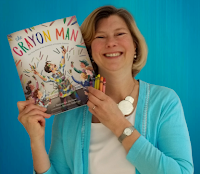 Natascha Biebow, MBE, Author, Editor and Mentor
Natascha Biebow, MBE, Author, Editor and Mentor Natascha is the author of the award-winning The Crayon Man: The True Story of the Invention of Crayola Crayons, illustrated by Steven Salerno, winner of the Irma Black Award for Excellence in Children's Books, and selected as a best STEM Book 2020. Editor of numerous prize-winning books, she runs Blue Elephant Storyshaping, an editing, coaching and mentoring service aimed at empowering writers and illustrators to fine-tune their work pre-submission, and is the Editorial Director for Five Quills. Find out about her new picture book webinar courses! She is Co-Regional Advisor (Co-Chair) of SCBWI British Isles. Find her at www.nataschabiebow.com
@font-face {font-family:"MS 明朝"; mso-font-charset:78; mso-generic-font-family:auto; mso-font-pitch:variable; mso-font-signature:-536870145 1791491579 18 0 131231 0;}@font-face {font-family:"Cambria Math"; panose-1:2 4 5 3 5 4 6 3 2 4; mso-font-charset:0; mso-generic-font-family:auto; mso-font-pitch:variable; mso-font-signature:-536870145 1107305727 0 0 415 0;}@font-face {font-family:"Trebuchet MS"; panose-1:2 11 6 3 2 2 2 2 2 4; mso-font-charset:0; mso-generic-font-family:auto; mso-font-pitch:variable; mso-font-signature:647 0 0 0 159 0;}p.MsoNormal, li.MsoNormal, div.MsoNormal {mso-style-unhide:no; mso-style-qformat:yes; mso-style-parent:""; margin:0cm; margin-bottom:.0001pt; mso-pagination:widow-orphan; font-size:12.0pt; font-family:"Times New Roman"; mso-fareast-font-family:"MS 明朝"; mso-fareast-theme-font:minor-fareast; mso-ansi-language:EN-US;}p {mso-style-priority:99; mso-margin-top-alt:auto; margin-right:0cm; mso-margin-bottom-alt:auto; margin-left:0cm; mso-pagination:widow-orphan; font-size:10.0pt; font-family:"Times New Roman"; mso-fareast-font-family:"MS 明朝"; mso-fareast-theme-font:minor-fareast;}.MsoChpDefault {mso-style-type:export-only; mso-default-props:yes; font-size:10.0pt; mso-ansi-font-size:10.0pt; mso-bidi-font-size:10.0pt; mso-fareast-font-family:"MS 明朝"; mso-fareast-theme-font:minor-fareast; mso-fareast-language:JA;}div.WordSection1 {page:WordSection1;}
May 22, 2022
Five Tips for an Amazing Author Visit by Chitra Soundar
As a children’s author, I’m often invited into schools, libraries and festivals to tell stories and share my book with children and often parents.
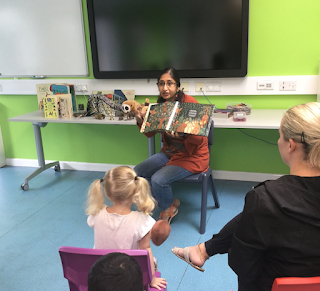 Illustrated by Poonam Mistry
Illustrated by Poonam MistryIf you’ve written a picture book and got it published, then you might want to visit schools to share your stories.
Here are five tips for a wonderful author visit.
1) Read the book aloud many times, knowing when to dramatize, where to change voices, how each character sounds. Prepare for the visit.
Remember picture books are usually shared with children from 3 years old. So it’s important to engage them with the reading. When I read You’re Safe With Me to children, I change the voice for each animal in the story, that matches their personality, and the dialogue. You can try this out with your own family or friends to get prepared.
Here is my reading of Tiger Troubles (illustrated by Hannah Marks) that helps illustrate this.
2) Expand and stretch the story. Introduce nursery rhymes as appropriate to break up the reading. Children love to join in and they enjoy and remember the experience when they can participate instead of being passive listeners.
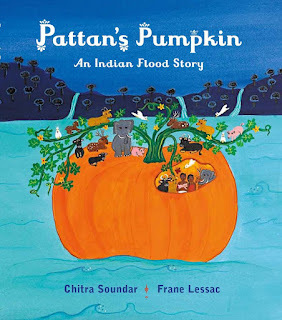 Illustrated by Frané Lessac
Illustrated by Frané LessacFor example, when I tell the story of Pattan’s Pumpkin, as the pumpkin floats, we sing Row, Row, Row the boat together with some relevant changes in the words that surprise the children and the adults alike.
3) Carry props - they could be shop-bought, handmade. But it adds a new dimension to the listening. Children can see and touch the object (pre-covid of course) especially if the characters or things in your story are new to the listeners. When I tell the story of Manju's Magic Wishes and the sequel Manju's Magic Muddle (both illustrated by Veronica Montoya), I carry a magic lamp with me and it is fascinating to see how the little ones are definitely happy to suspend disbelief and imagine the magic. And that's magic.
4) Ask the publisher for a pdf version of the story and convert it to a slideshow (google can help you find tools to do this). In every class, there will be children who need visual cues to keep their attention. Also it honours the craft of the illustrator to show the children the art from the book and talk about it. Just remember not to leave the presentation / pdf behind in a school or festival computer.
5) Create activities for the story – be it a colouring sheet (ask the publisher to give you one from the book) or a word search puzzle (google for this too) or a craft activity children can learn to do from the teachers. Check out my dedicated website for book related activities here.
That's just five tips from the tip of the author visit iceberg I've shared with you. What are your tips to bring your book to readers and listeners? Share in the comments.
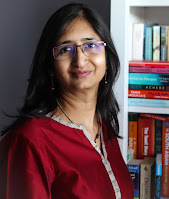
Chitra Soundar is an internationally published, award-winning author and storyteller, who is inspired by mythology, culture and folktales from across the world. She believes every story needs to be celebrated and there is a story behind every celebration.
Her latest picture books are Holi Hai! And We All Celebrate. Find out more at http://www.chitrasoundar.com/ and follow her on twitter here and Instagram here.
May 15, 2022
Character Driven versus Plot Driven, by Cath Jones
When you’re writing a picture book, have you ever considered whether your story is ‘plot driven’ or ‘character driven’? It’s quite possible that you’ve never really thought about this. Perhaps you’re not even one hundred percent sure what these terms mean. Decades ago, when I first started writing stories for children, I had not even heard of ‘Plot driven’ or ‘character driven’. I just wrote instinctively.
This is how I now define the two concepts:
If you tend to focus on events, then the chances are your story is ‘plot driven’.But if your character changes or develops during the story, or they come to a greater understanding of themselves, then your story is probably ‘character driven’. Ask yourself, is the personality of my character moving the story forward?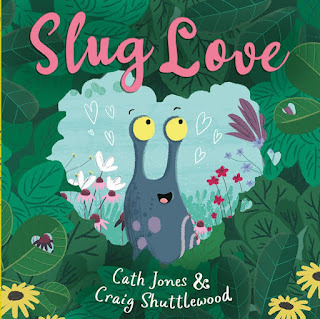
When I came to write this blog post, I realised I had no idea whether I was a plot driven or character driven writer! So I thought about some of my own stories.
My next picture book, ‘Slug Love’ (publishing June 2022) follows a pretty classic plot structure so does that mean I am plot driven? Not necessarily!
The plot may follow a pretty classic structure of problem to be solved, situation worsening, all is lost moment and a twist ending but all the action is driven by the optimism and determination of Slug. So that sounds like my story is definitely character driven.
What clinched the answer for me was the realisation that, when people asked me what my story was about, I always answered:
“Oh it’s about an optimistic slug,”
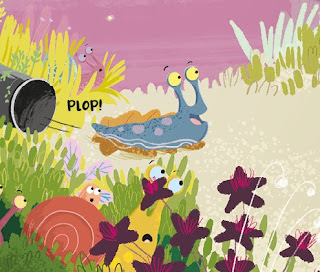
Rather than describing the plot or the problem, I always described Slug, the central character. And from the moment I started writing ‘Slug Love’, Slug was the star of the story, not the plot! In fact, I really struggled to get the plot to work. It took me literally years to reach the final draft.
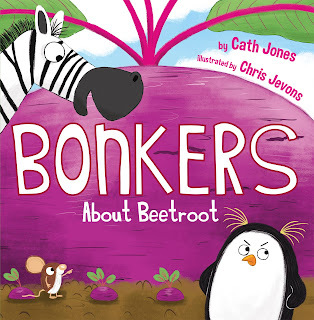
‘Bonkers About Beetroot was my first traditionally published picture book.’ When I set out, it was definitely plot driven. There was a problem to be solved and that was the plot. Simple.
However, what really makes this picture book (apart from Chris Jevon’s stunning illustrations of course) are the two main characters. At the heart of the story is an optimistic and determined Zebra and a pessimistic, rather grumpy penguin. If I had not populated a classic plot structure with two larger than life characters, the story would have been pretty uninspiring. And I will admit that the original germ of an idea for this story was a purple zebra and the title. The plot definitely came later.
But let’s see what other picture book authors think about character versus plot. I asked a few to consider their own books and writing style. Did they think they were plot driven or character driven?
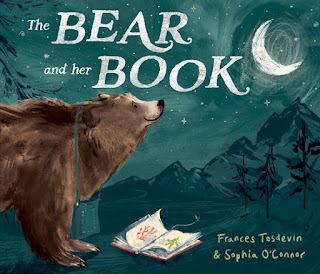
Frances Tosdevin, author of the 2021 picture book THE BEAR AND HER BOOK (illustrated by Sophia O’Connor) said:
“The Bear and her Book started off as plot-driven because I wanted to have lots of interesting visual possibilities in the text. But I do feel that the bear's character drove the plot, too— her kindness came out the more I got to know her. The creatures she meets (hopefully) all have their own personalities, too.
However, in general, I do try to have a mix of both plot and character in my stories, as I think they are quite interdependent, and also somewhat necessary!”
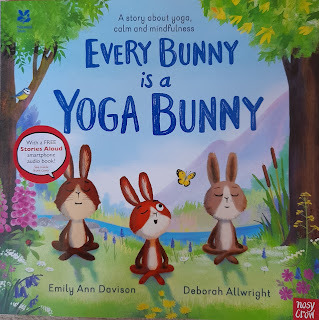
I’m sure many of you will relate to what picture book author Emily Ann Davison said:
“I do sometimes try to plot a story that is one or the other but most stories just fall out of my brain.”
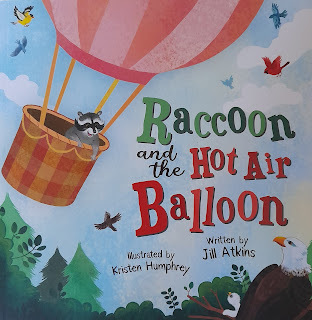
Jill Atkins, author of the 2021 picture book ‘Raccoon and the Hot Air Balloon’ and over 150 other books explained:
“In Raccoon’s case I began by wanting to write a story about a raccoon who was adventurous but kind. Then the plot fell into place... But sometimes the plot just comes to me and the characters develop from that.”

Lou Treleaven author of eight picture books, said:
“I think I'm probably plot driven but I find that in picture books the plot is so bound up with the character that you can't really separate them. The character IS the plot! For example in the Snugglewump the fact that the Snugglewump is just a piece of fabric compared to the other toys means it's going to feel inferior and unloved, so it had to be that character to make the plot work. But I've just realised that in my last few books I have started with the title and worked from there, and the title is a microcosm of the book, eg The Knight Who Might was a title that came to me when I was playing around with words, and that of course invokes the idea of a clumsy knight, and then the knight needs a challenge to see if he can get over his clumsiness. The fact that he believes he is the Knight Who Might against all the odds shows his self belief and determination. Again, the character is the plot. So maybe it would be better to say my writing is concept-driven!”
Personally, I think on the whole, you need BOTH a clear plot and brilliant characters. If the reader doesn’t care about what happens to the characters, it doesn’t matter how amazing the plot is. To write a brilliant picture book, I think you need to be a master of both plot and character. To create a great story one needs to find a balance between plot and character.
So, now you know! Do you set out with a great plot or some brilliant characters? Are you plot driven or character driven? I’d love to hear your thoughts.
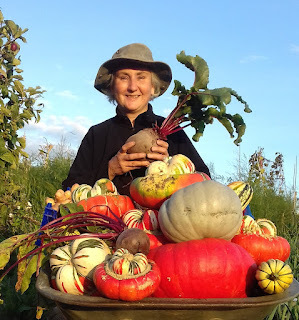
Cath is the author of scores of early readers, junior and middle grade fiction and a couple of quirky picture books. She’s passionate about diversity and strong female characters. She’s particularly proud of The Best Wedding Gift, a story featuring a child with two mums. Her life is dominated by vegetable growing, picking up litter and swimming in the sea. Cath lives in Kent with her wife and a spoilt rescue cat.
May 8, 2022
What Do You Mean? by Pippa Goodhart
How much does it matter that children understand every word that we write in picture books?
One quick answer is that of course picture book readings are a wonderful way for children to learn language as it's used in context. For that reason we wouldn’t ever restrict texts to only the language that children already know. But what if none of the text makes sense to them?
When I was a child our family picture books were Phyllis Krasilovsky’s 'The Cow That Fell Into The Canal', Robert McCloskey’s ‘Make Way for Ducklings’, and the Brian Wildsmith ‘Alphabet’. But my mother’s Swiss cousins also sent us some beautiful Swiss picture books with Swiss-German texts. I loved them! Here is one called ‘Knirps’, by Max Bollinger and Klaus Brunner.
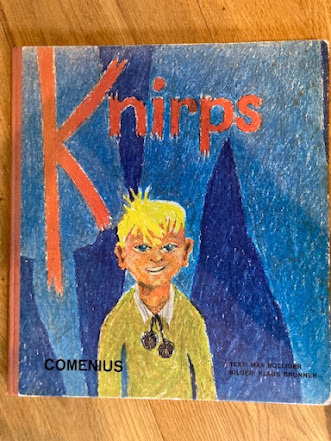
I understood the name ‘Peter’ amongst the writing, but that was the single word in the whole text that I understood. However, I understood enough of the story to be captivated by it.
Look at some sad opening images, which surely any child could understand –
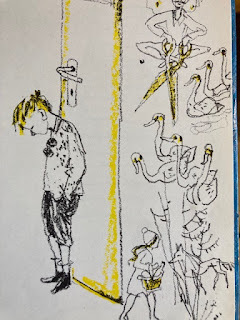
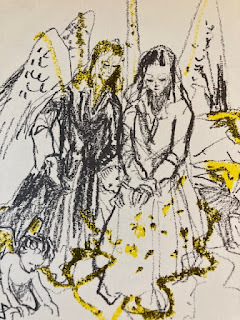
Then comes lush colourful nature. I don’t know what is happening to Peter at these points (he's not in the pictures), but I filled those gaps with my own ideas –
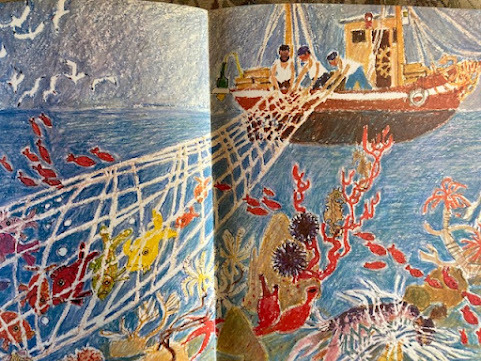
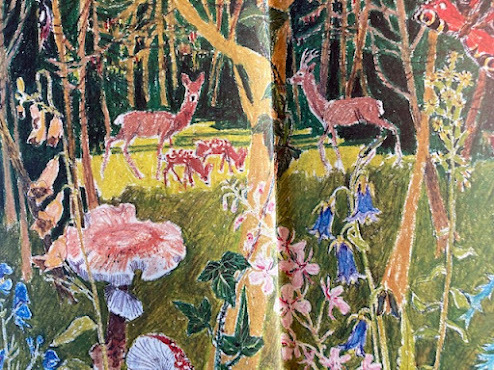
Before we end, returning to less lush colours, but this time a distinctly happy ending mood –
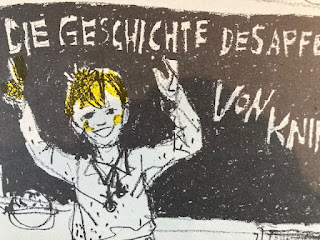
What is it that Peter has written on the blackboard? I still don't know.
My children grew-up loving ‘Pingu’ as tiny five minute television adventures about penguin Pingu, friends and family. Rather as The Clangers spoke in breathy hoots, Pingu and company speak in expressive musical notes. We perfectly understand what they are saying to each other, at least in terms of emotions.
Carson Ellis’ much more recent ‘Du Iz Tak?’ picture book similarly uses invented word sounds, but a good reader out loud of this picture book makes it totally accessible to young readers. They understand what is being communicated between the insect-human characters.
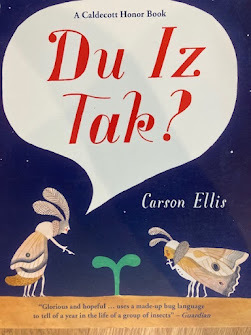
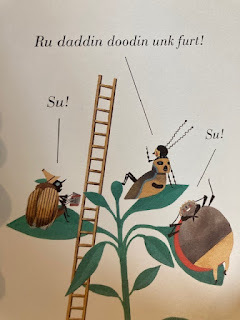
And of course young children are much more used to not understanding than we adults are. Language is new to them anyway, its sounds just beginning to have meaning, and finally enabling us to use those words to express things for ourselves.
There are many wordless picture books which let the pictures do all the communicating. But do you know of others where words are there, but in non-standard text ways that still speak to children?
May 2, 2022
SUCCESSFUL QUERY LETTERS AND ROUTES TO PUBLICATION by Clare Helen Welsh and friends
Following a recent Twitter thread, I decided to dedicate this post to successful query letters, in order to help aspiring creatives craft submissions that grab an industry professional’s attention. I contacted a few writer and illustrator friends to ask if they’d be happy to share the letters that helped get their publishing break.
Generally, the advice is that as long as you are professional, polite and well-written, a query letter won’t stand in the way of a fantastic submission. It’s a good idea to include a little your book, about you and about why you’re submitting to a particular individual. For those about to embark on the submission process, I’m delighted to be able to share two successful query letters that led to their owners’ picture book careers. Thanks so much to the generosity of the two writers!
QUERY LETTER ONE: Thank you anonymous writer!
Dear [agent’s name],
I am seeking representation and really hope you might consider me. I very much respect you as an agent and admire the authors on your list – in fact, I’ve been inspired to get in touch seeing all the new talent you’ve added recently (and their backgrounds and styles). I think my style could sit well alongside these clients, but also offer my own unique tone.
As per your submission guidelines, I am attaching three full 32-page picture book manuscripts. The first two are around 600 words long and aimed at ages 2-4 (but of course hoping to appeal to adults too!), while the third is a short-and-sweet 100-word rhyme for ages 1-3:
[3 picture book titles and synopses here]
Finally, I have also attached a short board book text for you to see as a sample of my board book writing (published in 2017). I am interested in both picture book and board book writing and would feel comfortable offering my own ideas or writing to a brief for both of these.
I have previously published the picture book [title and publisher]. It was the first of that publisher’s books to be read on CBeebies Bedtime Stories, and the iBooks version reached the top 10 in the iTunes free bookstore. I hold an Honours BA in English: Professional Writing and an MA in Creative Writing.
I would really appreciate your consideration of my work and I’ll keep my fingers crossed that something appeals to you. I’d be happy to discuss my submissions and other ideas I have at your convenience.
Thank you very much for your time, and I hope to hear from you soon.
QUERY LETTER TWO: Thank you, Simon Philip!
Dear Sallyanne,
Picture Book Submission
I am seeking an agent for my first children’s picture books: I Really Want The Cake and I Don’t Know What To Call My Cat! Given your experience and passion for working with debut authors, I would love that agent to be you.
The manuscripts I’m submitting (exclusively) are silly, short and simple. They contain lots of rhyme and repetition, and are aimed at the 3-6 age range. I think they distinguish themselves through their simplicity, perspective and humour, though I suppose they are influenced to some extent by three of my favourite picture books:
Bear’s Big Bottom, Don’t Let The Pigeon Drive The Bus, and I Want My Hat Back.
Written in the first person, I Really Want The Cake (249 words) is about temptation, willpower and, of course, cake. Very simply, there’s a cake, and the narrator wants it. The story follows the narrator’s psychological, physical and emotional reaction to the cake, and although forbidden from doing so, the narrator eventually gives in and eats the cake.
You’d have thought it would be easy to name a cat. It’s not. I Don’t Know What To Call My Cat!(259 words) makes this abundantly clear. Also written in the first person, it opens with the narrator’s plea to the listener for help with naming their cat. It describes the cat’s personality, and its reaction to various names (Trevor, Sir, Big Bad Boss, Tubbs McWhiskerson, etc…), all of which were just no good. Maybe the listener can come up with something the cat will like…
Although I started writing children’s stories relatively recently, I’ve since done much to try to become a better writer. I’ve read lots of picture books, volunteered at my local library to see what kids are reading, and have written numerous manuscripts, subjecting my family (the more intelligent members, anyway…), several teachers, numerous parents of small children, some real-life children, and the members of an online writing group, to all of them. I guess I’m trying to get across that I’m serious about writing picture books. Because I’m mean (and passionate), I even made someone suffering from viral tonsillitis read my stories, and even she laughed, so I’m hoping that the humour has a wide-enough appeal.
Thank you very much for considering my submission. I look forward to hearing from you.
Yours sincerely,
Simon Philip
After I’d begun chatting about successful query letters with picture book pals, this post took an unexpected turn. What became apparent is that many of us, me included, didn’t get our first deals through the traditional submission route, and some did but had found considerable success before, which they mentioned when querying. Others found ways to make their submissions personal, giving them the best chance.
Here are some anecdotes and pieces of advice from a selection of picture book writers and illustrators who talk about the journey to their first deal.
KAREN SWANN – COMPETITIONS

Karen is the author of The Tale and the Whale, illustrated by Padmacandra. Karen won the Writing Magazine Picture Book Prize with the story. She also came runner up in the Stratford Salariya Prize with a different story, which she mentioned in her successful publisher letters and in her agent query letter.
“Writing competitions can be a great way to gain feedback from industry professionals on your path to publication. They can be a boost to confidence if placed and give you something extra to put on your query letter to agents or publishers.”
KATE THOMPSON – OPPORTUNITIES ON SOCIAL MEDIA
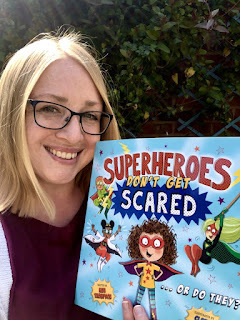
Kate is the author of Superheroes Don’t get Scared, illustrated by Clare Elsom, published with Trigger Publishing (now Welbeck Kids). She signed with Jo Williamson of Antony Harwood Ltd after placing second in a SCBWI Slushpile contest for chapter book and middle-grade texts. Kate’s advice is:
"Keep an eye out on social media for announcements from publishers and agents with details of manuscript wish lists and/or open submission windows. Tailoring your submissions and sending them to the right person at the right time can make all the difference. I secured my publishing contract for Superheroes Don't Get Scared while I was still unagented, and it was all thanks to seeing a tweet announcing that a brand-new mental health children's publisher was looking for picture book submissions."
FIONA BARKER – SMALL PRESSES
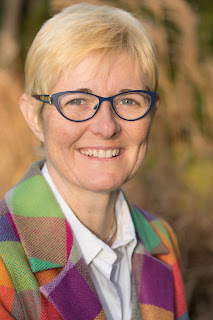
Fiona is the author of the picture books Danny The Dream Dog and Setsuko and the Song of the Sea, both illustrated by Howard Gray, published with Tiny Tree Children's Books. She also has two new picture books in the works with Scholastic and Quarto both due out in October. Fiona reflected on her journey to publication and shared her thoughts with me on submitting to and working with smaller, independent publishers :
“Don’t dismiss small presses. I hear lots of people say ‘hold out for a bigger publisher’ or ‘it will put a big publisher off if you’re already self-published or published with a small press’. My experience is that’s not the case. Small presses can be wonderful. They’re often very hands on with each text and really supportive as they’re usually only bringing out a small number of titles per year. If you later get to pitch something to a bigger publisher, if they like it and it fits on their list, they won’t care if you’re already published. Obviously, the caveat to that is that whatever you bring out, whoever it’s with, it should be the best it can be so do your homework on making the text sing and due diligence on the publisher but otherwise, I’d say definitely don’t dismiss the smaller presses because of some perceived snobbery that the bigger publishers with think you're somehow ‘tainted’. That’s nonsense. ”
From an author-illustrator perspective, Emma Reynold’s agent - Thao Le - found herthrough Twitter. Thao DM’d Emma because she liked her work! Thao is an agent based in the US and Emma in the UK.
My journey wasn’t via traditional routes either, after winning a scholarship to attend the SCBWI conference in Winchester, I saved up and bought my own ticket and a 1:1 the following year. Back then, you didn’t know who your 1:1 would be with, or even if it was an agent or editor. Thankfully, it worked out brilliantly for me. I was assigned a 1:1 with agent Alice Williams, who read and fed back on a picture book text. She felt my story was a bit on the dark side (!) but asked me to re-resubmit with additional texts… and the rest is history!
If you’re worried about the cost of competitions and 1:1s and conferences, do look out for free or subsidised opportunities. Write Mentor, SCWBI and I Am in Print offer scholarships to events and courses, and the SCWBI offers grants for WIPS. There are also free and subsidised competitions.
Penguin’s WriteNow scheme might also be of interest. Some publishers, such as Nosy Crow, are open to unsolicited submissions if you identify with an under-represented group. And if you don’t follow Amy Sparkes (aka The Story Godmother) on Twitter, you definitely should! She regularly offers free (and very reasonable priced) support for writers, which I can personally recommend.
But please don’t be disheartened. Authors and illustrators DO get their breakthroughs submitting query letters alongside texts and by following the guidelines.
- Lu Fraser, author of The Littlest Yak(Kate Hindley), One Camel Called Doug (Sarah Warbuton) and The Witchling’s Wish (Sarah Massini), found her agent by submitting to the slushpile.
- David Crosby, author of Which Nose for Witch? (Carolina Coroa) and Pirates VS Monsters (Lee Cosgrove) submitted directly to Maverick Books Publishing who gave him his first break. He wrote a Twitter thread about it. More details here: https://twitter.com/david_r_crosby/status/1360247222613528577?s=21
-
Paddy Donnelly, author and illustrator of books including The Vanishing Lake and Dodo’s Are Not Extinct got his agent through the traditional route, too, by following their submission guidelines and having an impressive portfolio.-
Laura Baker, author of The Colour Happy (Angie Rozelaar) and My Friend Sleep (Hannah Peck) had this nugget of advice to add about query letters. “I waited until I felt completely sure I was ready to submit before contacting anyone. I went straight to Jodie Hodges. I looked at recent signings to get an idea of what she was looking for and made sure I felt my texts were similar but different.”If you’re on submission or plan to be soon (and even if you’re not!) I thought it might be fun to end this post with some advice about how NOT to submit your work. Please enjoy my mock up query letter of what not to do and say when submitting your picture books.
I hope it makes you laugh – and good luck if you’re on submission!
Dear Mr Clair Welsh,
According to your agency’s website you’re actively seeking picture book submissions, so I thought I’d send you my middle grade novel.
Even though your manuscript wish list says you’re looking for commercial texts starring children as main characters, this text is about a very specific species of woodworm that reside in my writing desk.
Even though I have no previous writing experience, this novel won me an honourable mention from my kids at bedtime, so I am sure this story will make us both very rich!
It is complete at 3, 400, 001 words and is comparable to Where the Wild Things Are and will probably sell more books than the Bible and The Hungry Caterpillar combined.
Since you care deeply about animal main characters and middle grade novels, we are clearly a perfect fit. Therefore, even though you ask for submissions to be 1000 words maximum, I have included the first ten pages and look forward to hearing from you.
I can send you the other eight books in the series on request.
Yours sincerely,
Your future best-selling client
P.S. Julia Donaldson is my best friend!
BIO: Clare is a children's writer from Devon. She writes fiction and non-fiction picture book texts - sometimes funny, sometimes lyrical and everything in between. Her first book was published in 2015, and she currently has books in development with Little Tiger Press, Quarto, Nosy Crow and MacMillan. Her next picture book, publishing on 3rd May 2022 is 'How Messy!' - the third in the Dot and Duck series, illustrated by Olivier Tallec. You can find out more about Clare at her website www.clarehelenwelsh.com or on Twitter @ClareHelenWelsh.
April 24, 2022
Non-Fiction or Not Non-Fiction - that is the Question...

My new book The Greatest Show is coming out imminently. It’s the story of life on Earth, performed by insects in a shoebox theatre. It’s described as ‘Non-Fiction’. But is it?
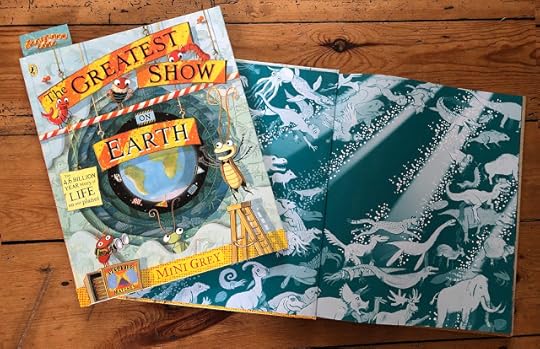
In this post I want to tell you a bit about my experience of wrestling with deep geological time and the paleontological past of Earth, show you my favourite research books, and look at a few non-fiction picture books and how they use the page visually… and maybe have a peek at the boundaries of non-fiction – where’s the line where it becomes fiction?
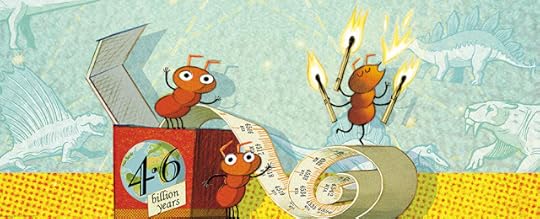
Researching the Greatest Show….
 This is a Very Useful Chart for keeping track of your geological eras of the Earth
This is a Very Useful Chart for keeping track of your geological eras of the EarthI don't have a proper science background, and I found when I was trying to research periods of time for the Greatest Show that what was tricky was that information didn't stick, so when I came to each page to build the pictures, I had to research it all anew. My double page spreads were roughly 50 cm wide - which worked well for quite a lot of geological periods – there was often about 50 million years between whatever event (usually some sort of mass extinction) marked a new time zone. My Tape Measure of Time – could unfurl at a scale of 1cm to 1 million years.
 But 50 million years is a REALLY long time, and I had to make my slice of tape measure just tell one or two main stories about the climate, so I needed to know enough about everything that happened to be able to decide what was important.
But 50 million years is a REALLY long time, and I had to make my slice of tape measure just tell one or two main stories about the climate, so I needed to know enough about everything that happened to be able to decide what was important.
 In this slice of Tape Measure, Annette and Anton are showing how oxygen levels rose in the Carboniferous era.
In this slice of Tape Measure, Annette and Anton are showing how oxygen levels rose in the Carboniferous era. This is where there's the WORST MASS EXTINCTION of ALL TIME, at the Permian-Triassic boundary.
This is where there's the WORST MASS EXTINCTION of ALL TIME, at the Permian-Triassic boundary. This is that quite recent mass extinction when Alan the Asteroid extinctified the dinosaurs (and lots of other animals.)
This is that quite recent mass extinction when Alan the Asteroid extinctified the dinosaurs (and lots of other animals.)There is so much information online and of course there’s the treasury of free information that is Wikipedia and also research papers and science journals. I spent quite a lot of time trying to work out what a sauropod lung might have looked like. I discovered proper scientists are super-helpful if you email them a query about something.
But whenever I got bogged down or mind-boggled about how to boil down Earth’s massively intense and complicated story, I had three go-to children’s information books. So here are my three Earth-Story bibles:
Book One: Dinosaurs: A Children's Encyclopedia
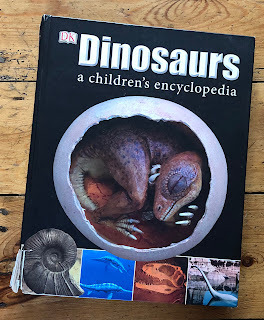 Pub. 2011, consultant Darren Naish. It's about so much more than dinosaurs, just about every other life form is in there as well.
Pub. 2011, consultant Darren Naish. It's about so much more than dinosaurs, just about every other life form is in there as well.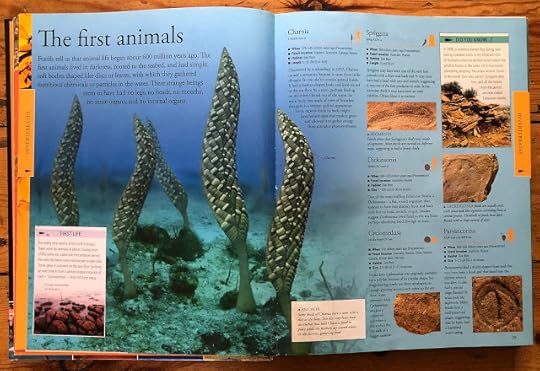 I'm always captivated by this glimpse of Ediacaran sea and swaying Charnias, it's like going in a time machine for a visit.
I'm always captivated by this glimpse of Ediacaran sea and swaying Charnias, it's like going in a time machine for a visit.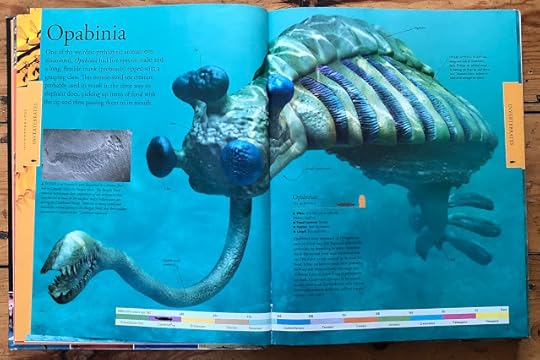 Here's a Precambrian animal, Opabinia, with its random five eyes, reaching out of the page to shake you by the hand.
Here's a Precambrian animal, Opabinia, with its random five eyes, reaching out of the page to shake you by the hand.Book Two: Hannah Bonner's Prehistoric Trilogy (OK I’m cheating, this is obviously three books.)
 When Bugs Were Big, When Fish Got Feet, and When Dinos Dawned, all by Hannah Bonner.
When Bugs Were Big, When Fish Got Feet, and When Dinos Dawned, all by Hannah Bonner. Hannah does it all - makes the words and the pictures, and works out how to explain with humour the most properly deep scientific concepts. On this page, as well as providing a glimpse of an early Triassic landscape from the point of view of a hungry Luperosuchus, on the left hand side we can trace our mammal ancestry back to when we were egg-laying amniotes and a shared ancestor of dinosaurs.
Hannah does it all - makes the words and the pictures, and works out how to explain with humour the most properly deep scientific concepts. On this page, as well as providing a glimpse of an early Triassic landscape from the point of view of a hungry Luperosuchus, on the left hand side we can trace our mammal ancestry back to when we were egg-laying amniotes and a shared ancestor of dinosaurs.Book Three: The What on Earth? Wallbook of Natural History
 by Christopher Lloyd and Andy Forshaw. You can see it's so well used that it has collapsed.
by Christopher Lloyd and Andy Forshaw. You can see it's so well used that it has collapsed.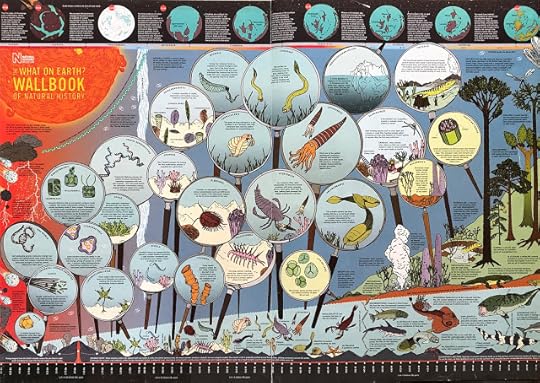 This book is a big zig-zag timeline. It's organised into different levels to simultaneously show EVERYTHING, including: evolution on sea and land, the changing climate, the moving continents, geological activity and mass extinctions.
This book is a big zig-zag timeline. It's organised into different levels to simultaneously show EVERYTHING, including: evolution on sea and land, the changing climate, the moving continents, geological activity and mass extinctions. Non-fiction is a picture book challenge – to make and also to read. Reading non-fiction can be a difficult for those who like a well-aerated page, who get distracted and confused if there’s too much to see on the page (like me). So it's a visual challenge to design non-fiction pages that say what they need to, but in a digestible way, and I think the non-fiction illustrator has to use every element at their disposal to distill the message they want to tell.
Just grabbing a few favourite non-fictions from my bookshelves, I have picked out Animalium, Professor Astro Cat and On the Origin of Species.
From my bookshelves: Animalium
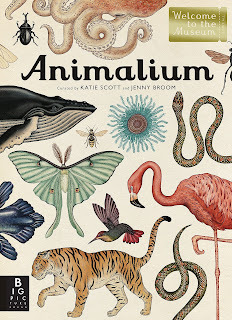 by Katie Scott and Jenny Bloom
by Katie Scott and Jenny Bloom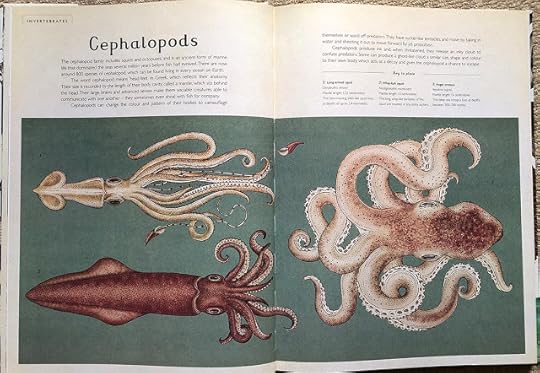 This is a book that is really a Natural History Museum, with exhibits that we feel we can reach out and touch. It also reminds me of a Cabinet of Curiosities, like the Natural Curiosities of Albertus Seba.
This is a book that is really a Natural History Museum, with exhibits that we feel we can reach out and touch. It also reminds me of a Cabinet of Curiosities, like the Natural Curiosities of Albertus Seba. It's on a generous scale, like the Birds of Audobon. There's lots of space for the exhibits, who are large. The displays show what's inside animals and also terrariums of creatures assembled.
It's on a generous scale, like the Birds of Audobon. There's lots of space for the exhibits, who are large. The displays show what's inside animals and also terrariums of creatures assembled.From my bookshelves: Professor Astro Cat's Frontiers of Space
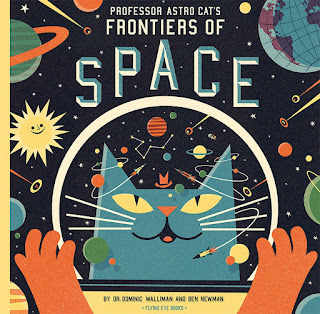 by Dr Dominic Walliman and Ben Newman
by Dr Dominic Walliman and Ben Newman
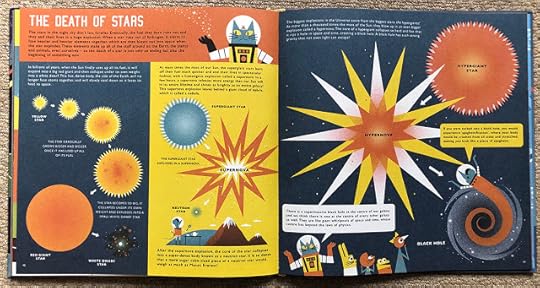 The designs and illustrations of Ben Newman use shape and proportions and retro colour palettes to bring a lot of physics to the reader.
The designs and illustrations of Ben Newman use shape and proportions and retro colour palettes to bring a lot of physics to the reader. Find a solar system in your fruit bowl.
Find a solar system in your fruit bowl.From my bookshelves: On the Origin of Species
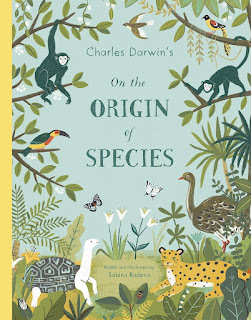 by Sabina Radeva
by Sabina Radeva I love how Sabina has used quotes from Darwin's actual On The Origins of Species to show the beauty and awe in his view of evolution. I love this transformation of Earth's fossil layers into "a vast museum".
I love how Sabina has used quotes from Darwin's actual On The Origins of Species to show the beauty and awe in his view of evolution. I love this transformation of Earth's fossil layers into "a vast museum". In this spread Sabina demonstrates convergent evolution, and shows the evolutional possibilities of the tetrapod hand. Sabina uses flat colour in a limited palette to keep everything calm and clear on the eye.
In this spread Sabina demonstrates convergent evolution, and shows the evolutional possibilities of the tetrapod hand. Sabina uses flat colour in a limited palette to keep everything calm and clear on the eye.Non-Fiction or not Non-Fiction?

With the Greatest Show, the challenge was to bring Life on Earth to readers as a story. I wanted the reader to see at a glance THE MAIN STORY, to know where to look first. But then to be able to delve deeper in, if they wanted to. So I took the model of the theatre stage - where your main stage is your first focus, and then you can peruse the wings and also see what's going on down at the Tape Measure of Time.
 The Shoebox Theatre Plan - so you know where to look first to see in a snapshot what's going on.
The Shoebox Theatre Plan - so you know where to look first to see in a snapshot what's going on.But NOTHING in this book is at all realistic or like it really would have been. I mean - do insects do puppetry? Can they read? Would a cockroach be able to operate a spoon? Even my troupe of insects – well, they haven’t got mandibles and compound eyes – but then it’s hard to feel empathy for the true face of an insect.
 The True Face of an Insect (this one's a beetle.)
The True Face of an Insect (this one's a beetle.)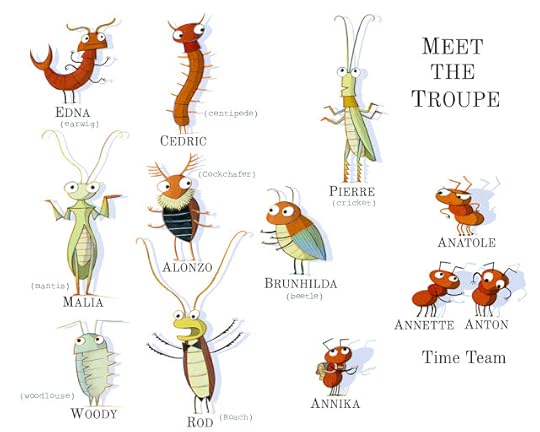 My troupe of critters
My troupe of crittersSo does Greatest Show rather stretch the definition of 'non-fiction'? Books get organised exclusively into 'fiction' and 'non-fiction', but is there a cross-over zone? The gap between fiction and non-fiction – is there one? Is there an overlap?
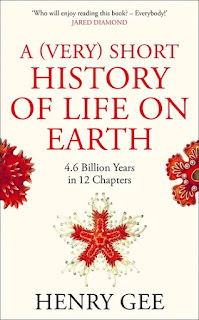 I highly recommend Henry Gee's vivid and entertaining romp through 4.6 billion years.
I highly recommend Henry Gee's vivid and entertaining romp through 4.6 billion years.Henry Gee’s book, A (Very) Short History of Life on Earth, tells it like a story. It starts: "Once upon a time, a giant star was dying." - and there we are, at the very beginning of the dawn of Earth, and its "Song of Fire and Ice". The story has acted like a time-portal, to transport us to witness the dear old Earth's very beginnings, and that's the magical thing that stories can do.

The World of Story
With my book I wanted to find out if there was a way of making the evolution of life on Earth over 4½ billion years into a story to give young readers a first scaffold to start hanging their knowledge of life on Earth upon. Why a story?

Because maybe humans are uniquely good at absorbing information through stories. Think of remembering with Memory Palaces, navigating with songlines. Before writing, story was how information was passed down generations. Stories are memorable. Story makes us want to know what happens, makes us pay attention.

But story is also a miracle. How is it possible that I can tell you a story of insects putting on a performance, and you’re prepared to go along with this crazy idea? It’s because of the power of story to seize our imaginations and curiosity. But we have to watch out – The Story’s power is really strong, and as we can see unfolding in the world today, its power can be used for good or for ill.

The Greatest Show on Earth is coming to shops on 28th April.
Another of Mini's book-involvements is The Book of Not Entirely Useful Advice, with AF Harrold. Her BlogSite is at Sketching Weakly.

